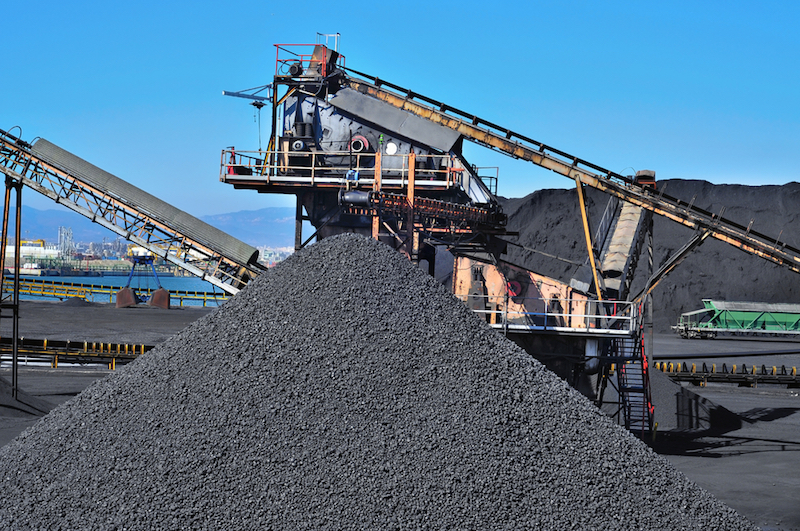Trump Touts 'Clean Coal': What Is It, Really?

At a recent rally in Phoenix, President Donald Trump spoke about opening a new coal mine in Pennsylvania, and referenced "clean coal." But what does it really mean when politicians throw out this term?
"We've ended the war on beautiful, clean coal," he said on Aug. 22. "It's just been announced that a second, brand-new coal mine, where they're going to take out clean coal — meaning, they're taking out coal, [and] they're going to clean it — is opening in the state of Pennsylvania, the second one."
Trump was referring to a mine from Corsa Coal Corp. that is projected to open in 2018. The reference to "clean coal" was somewhat unclear in this context, because clean coal refers to attempts to recapture carbon released when coal is burnt or to otherwise reduce coal pollution during the combustion process. It's not something that happens during the mining stage. [6 Politicians Who Got the Science Wrong]
In response to a reporter from Time magazine, the CEO of Corsa Coal, George Dethlefsen, wrote on Twitter that Trump was referring to the coal preparation process, which involves washing coal free of rock and soil. That cleaning process is separate from the usual usage of "clean coal" in the sense of carbon removal and pollution reduction.
Carbon capture
Trump's confusing use of "clean coal" is par for the course; the term itself is fairly vague and has no set definition, said Shiela Medina, the associate director of development and community management at the University of Kentucky's Center for Applied Energy Research.
p.p1 {margin: 0.0px 0.0px 0.0px 0.0px; font: 11.0px Calibri} span.s1 {font-kerning: none}
"As many people as you would ask to define it for you, they would say something different," Medina told Live Science.
Get the world’s most fascinating discoveries delivered straight to your inbox.
But, generally speaking, "clean coal" refers to a suite of technologies geared toward preventing climate change. These technologies are expensive, so they're typically funded through public-private partnerships with, and loans from, the U.S. Department of Energy.
One major arm of clean coal technology deals with carbon capture and storage. The goal is to grab carbon dioxide from industrial waste streams and then use it for something else — sometimes making other, more valuable chemicals or sometimes injecting it into oil-bearing rock deep underground to increase the amount of oil that can be recovered from a particular well.
Carbon dioxide (CO2) lowers the viscosity of oil and helps it move through the pores of the rock reservoir, according to the U.S. Geological Survey. In other cases, the goal is simply to stick the CO2 into deep rock reservoirs. One active project funded by the Department of Energy's National Energy Technology Laboratory (NETL) is attempting to take carbon dioxide produced during ethanol refining and inject it into sandstone reservoirs in Illinois.
Scrubbing carbon dioxide out of an emission stream isn't particularly difficult, chemically speaking. Chemicals called amines can bind to carbon dioxide and to hydrogen sulfide, another pollutant in coal combustion. The problem is that the process takes a huge amount of energy and space, Medina said. The entire emissions stream from a coal-burning power plant, known as flue gas, must be run through a bubbling solvent to get the chemical reaction that pulls out the carbon dioxide. This solvent-and-CO2-mixture must then be heated to remove the greenhouse gas for compression, transport and storage. [8 Ways Global Warming Is Already Changing the World]
"The equipment is enormous," she said. "It might be the size of the whole power plant. It's acres."
And it's expensive. All that heat is costly, Medina said. A power plant might have to use one-third of its entire output just to clean its emissions of carbon. That's why adding carbon capture to a plant would as much as double the cost of electricity, she said.
There are problems on the storage end, too, Medina added. The utility that runs the carbon capture plant would be responsible for carbon stored in a rock reservoir "in perpetuity," she said, meaning that if that CO2 ever got released somehow, the utility would be liable. That's a big deterrent.
And even reusing the CO2 in oil fields comes with challenges, she said.
"In general, coal plants are not located next to oil wells," Medina said. Getting the greenhouse gas to the right place requires pipelines — and more expense. Additionally, carbon dioxide [that's] used to improve oil recovery only partially remedies the problem, as not all of the injected carbon dioxide stays in the ground, according to a 2014 study published in the journal Frontiers in Energy Research.
Some scientists and climate change researchers argue that carbon capture and storage will be necessary to prevent catastrophic climate change. On the basic research side, scientists are looking for new heat sources — like the heat of a power plant's waste stream itself — and for new solvents that will require less heat to pick up and release carbon dioxide, Medina said.
Coal gasification
The second major arm of "clean coal" is coal gasification. This process involves converting coal into a mixture of carbon monoxide and hydrogen called "syngas." This removes nasty pollutants like sulfur and nitrogen oxides so that the syngas burns "cleaner" than coal, according to the Department of Energy.
However, it's hard for coal gasification to compete with natural gas, which naturally emits less carbon dioxide when burned than coal does. The ability to drill horizontal oil and gas wells and to "frack" shale by injecting pressurized sand and chemicals into the rock has enabled a huge boom in natural-gas production over the past decade.
In 2005, U.S. producers put 18.9 trillion cubic feet (535 billion cubic meters) of natural gas on the market, according to the U.S. Energy Information Administration. By 2016, that number was at about 28.3 trillion cubic feet (800 billion cubic m). The boom in supply has caused a corresponding price decrease, so there is little incentive for the more costly, complex process of manufacturing syngas, Medina said.
The NETL has also funded programs in the past geared toward increasing the efficiency of power plants and reducing other pollutants from these plants' waste streams, but there are no current active projects in those programs today. [The Reality of Climate Change: 10 Myths Busted]
Clean coal policy
Though Trump has made clean coal a centerpiece of his speeches, his administration's policies have not always backed up his rhetoric. The president's 2018 budget proposal suggested 55 percent cuts to the Department of Energy's Fossil Energy Research and Development Program, which funds clean coal research and implementation, the news site Axios reported in May.
Clean coal projects depend on Department of Energy funding because banks aren't enthusiastic about making loans to back such expensive, unproven technology, Bloomberg reported in July. Thus, Trump's budget might threaten projects like a $3.8 billion plant in Lake Charles, Louisiana, meant to turn oil-refinery waste into valuable chemical projects and to capture carbon for oil recovery; that project relies on a $2 billion Department of Energy loan.
These cuts are unlikely to come to fruition, however, as the U.S. House of Representatives appropriations committees released a budget proposal in July that would keep Department of Energy funding flat rather than slashing it. Under this proposal, according to Science Magazine, the agency's fossil fuel programs would lose only $33 million annually, a 5 percent cut.
Original article on Live Science.

Stephanie Pappas is a contributing writer for Live Science, covering topics ranging from geoscience to archaeology to the human brain and behavior. She was previously a senior writer for Live Science but is now a freelancer based in Denver, Colorado, and regularly contributes to Scientific American and The Monitor, the monthly magazine of the American Psychological Association. Stephanie received a bachelor's degree in psychology from the University of South Carolina and a graduate certificate in science communication from the University of California, Santa Cruz.


